Trentino is a strange wine country. Although it is one of the smallest wine-growing regions in Italy, with just 9,000 hectares of vineyards, and most of the vines are planted on steep slopes that are difficult to work, the image of Trentino wine is mainly shaped by three large cooperatives - Cavit, Mezzacorona and the Cantina Sociale di Lavis - which fill the shelves of domestic supermarkets and the containers of bulk buyers in the USA, Great Britain and Germany with inexpensive varietal wines - above all Pinot Grigio. All these wines are technically well made, that is: clean, fruity and fresh. For many - unfortunately all too many - consumers, that seems to be enough. But those who demand unmistakable character of origin will certainly not be happy with these wines. Yet, due to its geographical and climatic conditions, Trentino has the best prerequisites for high-quality terroir wines. And these wines do exist in Trentino. They are mainly produced by the many small and medium-sized self-marketers based here, the Vignaioli del Trentino, who, however, are hardly known outside the country's borders. And the producers who are known, such as Pojer & Sandri, Elisabetta Foradori and the fine sparkling wine producer Ferrari, are rarely associated with their region of origin, Trentino. There have been, and still are, repeated efforts by the territorial wine marketing to give the wine region of Trentino an identity as a growing region of distinctive, independent quality wines. But all these attempts have ultimately failed because of the supposed success of Pinot Grigio & Co.
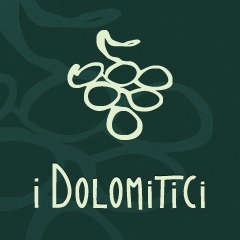 Since 2010, a private winegrowers' association has been trying to do what has not been successful on a large scale. Ten top Trentino wineries have joined forces to show what Trentino has to offer in terms of wine quality, but above all what it has to offer in terms of independence and unmistakable character. And what's more: they do this in a natural, i.e. organic or bio-dynamic way. They have named themselves after the mountains that characterise this alpine region: I Dolomitici. Ten producers is not much, even in a small growing area like Trentino, but they cover - with the exception of the hills of Faedo and the Val di Cembra - all the subzones of Trentino. These are: Campo Rotaliano with Trentino's famous autochthonous red wine, Teroldego; the hills north and east of Trento with its fine white wines; the magnificent Valle die Laghi to the north of Lake Garda with the sweet wine secret Vino Santo; and southern Trentino near Rovereto with its variety of wines as well as the local speciality Marzemino.
Since 2010, a private winegrowers' association has been trying to do what has not been successful on a large scale. Ten top Trentino wineries have joined forces to show what Trentino has to offer in terms of wine quality, but above all what it has to offer in terms of independence and unmistakable character. And what's more: they do this in a natural, i.e. organic or bio-dynamic way. They have named themselves after the mountains that characterise this alpine region: I Dolomitici. Ten producers is not much, even in a small growing area like Trentino, but they cover - with the exception of the hills of Faedo and the Val di Cembra - all the subzones of Trentino. These are: Campo Rotaliano with Trentino's famous autochthonous red wine, Teroldego; the hills north and east of Trento with its fine white wines; the magnificent Valle die Laghi to the north of Lake Garda with the sweet wine secret Vino Santo; and southern Trentino near Rovereto with its variety of wines as well as the local speciality Marzemino.
The Campo Rotaliano and 'La Signora Teroldego': Elisabetta Foradori
The Campo Rotaliano, with the two villages of Mezzocorona and Mezzolombardo growing into each other, is not really beautiful - apart from the magnificent mountains surrounding it. An exception is the winery of Elisabetta Foradori. Situated in the middle of the village of Mezzolombardo and surrounded by old walls like a French Clos, this place exudes a tranquillity rarely found even in less industrialised areas like Campo Rotaliano. This tranquillity is certainly not only due to the screening by the old stone walls, but above all to the way Elisabetta Foradori cultivates her vineyards. Being close to nature has always been important to her, and she was one of the first Italian top producers to convert her farm to organic or biodynamic farming methods. And so the chickens feel just as much at home here as the organic vegetables, which are allowed to grow in a part of the vineyard under high vine cones, as they used to be in Trentino.
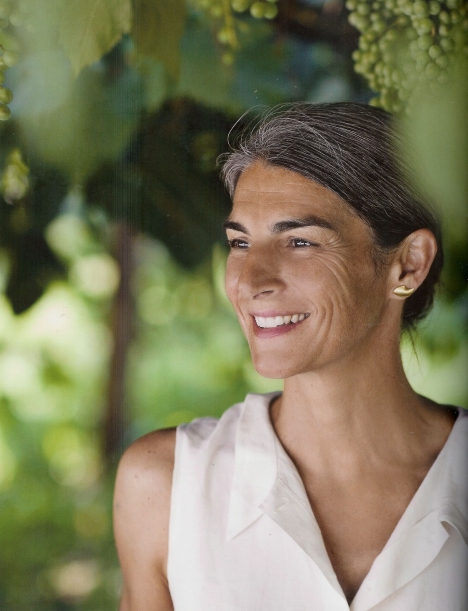 |
| Elisabetta Foradori (Source: Rui Camilo) |
Elisabetta Foradori earned her reputation with her Teroldego wines. This autoctone Trentino variety finds the best conditions on the alluvial soils of Campo Rotaliano. Like its South Tyrolean "cousin", the Lagrein, the Teroldego likes it warm and that is no problem in the Campo Rotaliano - Kessel. At the same time, the Campo Rotaliano with its stony, well-drained subsoil, in which granite, quartz, porphyry and limestone have been deposited, as well as with its rather cool nights, offers the best conditions for the Teroldego not to be ostentatious, striking, but to present itself rather cool, with restrained power and a certain austerity. The Foradori Teroldego - the 'Foradori' aged in cement tanks and the 'Morei' and 'Sqarzon' selections matured in amphorae - show this in pure culture. (see here). The most famous Teroldego of Elisabetta Fordori is the 'Granato', a selection from the oldest vines. The 'Granato' has changed a lot since it was first produced in 1986. In the beginning, it was very much influenced by the ageing in barriques, but now the peppery-berry aromas dominate with discreet wood, which, however, will no longer be noticeable in the future, because the small barrels will gradually disappear completely from the Foradori cellar.
The white wines - Nosiola and Manzoni Bianco - from Elisabetta Foradori are produced on slopes above Trento. The clay soils there as well as the cooler climate give the wines a fine minerality and juiciness. They are both macerated for some time and the Nosiola is aged in clay amphora like the Teroldego selections. Elisabetta Foradori does this not as a marketing gimmick, but because she is convinced that the amphora has a positive influence on the wine. On the one hand, it is the same material as is found in the soils on which the vines of the white wines are planted. On the other hand, the amphora - unlike the steel - or cement tank allows an exchange of oxygen without - like the barrique barrel - changing the taste of the wine. Both white wines are sold two years after the harvest at the earliest and can then mature for a good six to eight or even ten years.
Prices ex farm: the Teroldego wines cost between 15 euros and 36 euros (Granato), the white wines cost 16 euros (Manzoni Bianco) or 25 euros (Nosiola).
Visitors are welcome at any time by appointment.
Azienda Agricola Foradori S.S.
Via Damiano Chiesa, 1
38017 Mezzolombardo (TN)
Tel.: +39 0461 601046
Email: info@elisabettaforadori.com
www.elisabettaforadori.com
Valli dei Laghi: Holy wine and devilishly good schnapps
The Valli dei Laghi is certainly the most scenic area in Trentino's wine country. Opening onto Lake Garda, this valley with its lakes surrounded by mountains is simply a delight. And the typical products here make the enjoyment perfect. In addition to the Chardonnay, Sauvignon Blanc and Cabernet varieties also grown in other parts of the country, the Valli die Laghi offers some very special specialities with the dessert wine 'Vino Santo', the red wine Rebo and above all its wonderful grappas.
Alessandro Poli/Az. Agr. Francesco Poli
Alessandro Poli is one of the most relaxed representatives of his guild. One reason for this is certainly that his winery and distillery is a long-established traditional business with many loyal regular customers, which has no sales problems despite the numerous competitors of the same name (in Massenza there are three winegrowing and grappa producers with the Poli name). Another reason for Alessandro Poli's relaxed attitude is probably that the conversion to organic or biodynamic farming was not particularly difficult for him because of the natural conditions in the Valli dei Laghi. "Apart from the fact that we now have to comply with the necessary documentation requirements for organic certification, practically nothing has changed for us. The regular wind from Lake Garda ensures that our vineyards are well aerated, so we hardly ever have problems with fungal diseases, and we have never used herbicides anyway. An exciting new step for us has been to increase soil quality with biodynamic tillage." Although he has no major problems in terms of organic production, Alessandro Poli even goes one step further and grows the fungus-restricted varieties Bronner and Solaris on his highest vineyards, from which he presses a fine-aromatic white wine cuvée.
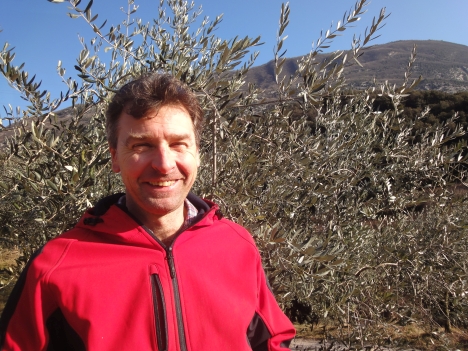 |
| Alessandro Poli (Source: Roland Brunner) |
Alessandro Poli has a wide range of varieties. In addition to Nosiola and the aforementioned cuvée of fungus-resistant varieties, there are two Frizzante wines made from Nosiola and the local speciality Peverella - one of which is fermented in the bottle 'Sur Lie'. In addition, there is a rosé made from Vernatsch (Italian: Schiava), three red wines and the Vino Santo, of which the Valli dei Laghi is particularly proud - and rightly so, because this wine is certainly one of the best dessert wines in Italy. It is made from Nosiola grapes, which are dried in small boxes under the roof. The roof is open on two sides, so that the wind that regularly comes from Lake Garda dries the grapes slowly. Around Easter of the year following the harvest, the grapes are pressed (hence the name Vino Santo) and then slowly fermented. This is followed by a long period of bottle ageing - Francesco Poli is currently offering his 2004 vintage. The Vino Santo is a classic straw wine - concentrated, intense, with a fine nutty aroma, at the same time it has a fascinating, very animating mountain freshness. Slow Food Italia included the Vino Santo in the category 'Presidio Slow', which honours high-quality local specialities that are particularly worthy of protection.
The Francesco Poli winery became famous for its grappa and fruit brandies. Depending on what is available for distillation and what Francesco Poli is in the mood for, up to 15 different varieties are distilled.
The range is completed by the extra virgin olive oil 'Estremo'.
Ex-farm prices range from 6.50 euros (Rosé) to 11 euros (Lagrein), the Vino Santo costs 26 euros (0.5 litre) and the grappas between 13 and 32 euros (0.50 litre).
Visitors are always welcome by appointment.
Az. Agr. Francesco Poli
Fraz. Santa Massenza, 36
38070 Vezzano (TN)
Tel.: ++39 0461 340090
Email: info@distilleriafrancesco.it
www.distilleriafrancesco.it
Gino Pedrotti
The memory of visiting Gino Pedrotti always brings a smile to my lips. When I arrived, Gino was redesigning his garden according to the specifications of a biodynamically trained landscape gardener. Gino is sitting on a digger struggling with an unanticipated pipe that needs to be shovelled free and removed, making the job much more difficult and a nerve-wracking grind. Nevertheless, Gino welcomes me with a hearty, cheerful laugh. The whole atmosphere at the winery is characterised by this hearty, friendly manner. A place where one simply enjoys spending time.
 |
| Gino Pedrotti (Source: Roland Brunner) |
Three white wines, a rosé, three reds, the dessert wine speciality of the Valli dei Laghi, the Vino Santo, and five grappas are produced. Among the white wines, the local speciality Nosiola is in the foreground. Like many of his Dolomitici colleagues, Gino Pedrotti lets the Nosiola grapes ferment for some time with the skins to give the wine more intensity without making it more alcoholic. In Gino Pedrotti's case, this procedure is noticeable in a particularly strong dry fruit component in both the aroma and the taste. This hearty, powerful style also characterises the white wine cuvée 'Aura' (Nosiola and Chardonnay) aged in wood. The single-varietal Chardonnay, on the other hand, has a fresh, fruity character. The rosé, a classic Vernatsch, combines uncomplicated drinking pleasure with a certain intensity; the Merlot, which is the only red wine not aged in wood, is fruity and round. The local speciality Rebo and the Cabernet/Merlot cuvée 'Auro' are aged in barriques. This is very good for the 'Auro', but in my opinion the Rebo loses some of its fineness. All dry Pedrotti wines are perfect accompaniments to hearty meals, whether it is a hearty snack or a noble dish. As in every winery in the Valle dei Laghi, the Pedrotti family is particularly proud of the Vino Santo, where the oxidative elements are somewhat more pronounced without making the wine 'look old' after more than 10 years.
Prices at the farm: wines from 7 (rosé) to 12 euros (Cabernet 'Auro'); the grappas cost 13 or 14 euros 50 (0.70 litres).
You don't have to register to taste wine, at least from June to September, because the Pedrotti family runs a bar that is open every day during this period. From October to May, the bar is open from Friday to Sunday.
Azienda Agricola Gino Pedrotti
Via Cavedine, 7
38073 Lago di Cavedine (TN)
Tel.: ++39 0461 564123
Email: info@ginopedrotti.it
Pressano - the "Dolomitici Nest
The small wine-growing village of Pressano near Trento has the highest density of Dolomitici members. Three of them are based here: Alessandro Fanti, Marco Zanoni and the Cesconi brothers. Since the early 1990s, they have regularly exchanged ideas on how to produce high-quality terroir wines with as little or preferably no chemicals. It seemed absurd to them to emphasise the terroir as a special wine quality when it consists of soils that have been treated with lots of chemicals. At the same time, as well-trained winemakers, they appreciated the advantages of modern technology in winemaking and wanted to combine it with natural cultivation.
Alessandro Fanti/Vignaiolo Giuseppe Fanti
Giuseppe Fanti, founder and namesake of the winery, was a pioneer. In 1972, he was the first to bottle a single-varietal Nosiola wine in 7/10ths bottles. He was already convinced at that time that this autoctone Trentino variety offered more than neutral taste and good acidity, which could be used to give other wines some freshness. "My father wanted to show that even this light, less aromatic wine has qualities that make it valuable and distinctive," says his son Alessandro Fanti, who has been in charge of the winery since 1991. He has succeeded in this. Which can still be verified today, provided Alessandro Fanti finds the time and muse to open one of the few remaining bottles of a wine produced by his father. Then it becomes apparent that the Nosiola, as inconspicuous as it sometimes seems in its youth, can develop very well in the bottle. The discreet, slightly nutty taste in the young wine intensifies with age, and at the same time the wine still has an animating, lively note even after many years.
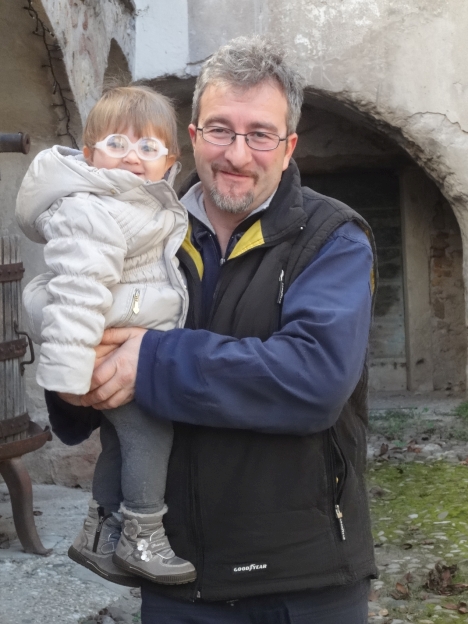 |
| Alessandro Fanti and his daughter (Source: Roland Brunner) |
The pioneering feat that his father achieved with the Nosiola was repeated by his son Giuseppe with another white wine variety: He was the first to bottle a single-varietal Manzoni Bianco. This variety was created in the 1930s from a cross between Riesling and Pinot Blanc. In terms of taste, Manzoni Bianco is the counterpart to Nosiola. Spicy, aromatic, with a strong aroma of ripe fruit and relatively high in alcohol. It reaches 14%, but this is not at all noticeable in the taste. Its strong and well-integrated acidity due to the abundance of fruit, as well as its minerality, ensure that this "high-proof" wine also presents itself as very fine and animating. A complex, full-bodied, but not heavy mountain wine. Like the Fanti winery's Nosiola, the Manzoni Bianco also has a very good ageing potential, which is why Alessandro Fanti only releases his "Isodor" selection, which comes from the highest vineyards and is only produced in particularly good years, for sale after two years and is happy about every bottle that is opened as late as possible, "because then the wine really shows what it's made of". The range is rounded off by the single-varietal white wines Chardonnay and Sauvignon as well as the white wine cuvée 'Pristianum' and the 'Portico Rosso', a red wine cuvée of Cabernet and Teroldego.
Prices ex farm: €8 (basic Nosiola) to €17 (selection Isidor).
Visitors are always welcome by appointment.
Vignaiolo Giuseppe Fanti
Via A. Pilati, 1
Pressano di Lavis (TN)
Tel.: ++39 0461 240809
Email: info@vignaiolofanti.it
www.vignaiolofanti.it
Marco Zanoni/Maso Furli
When we visited the Maso Furli winery, we got right down to business. Without saying much, Marco Zanoni grabbed the corkscrew to show what his wines have to offer. And they have a lot to offer. In addition to their individual qualities, they all have one thing in common: they are extremely ripe or in need of ripening. As good as the wines - white and red - are in their youth because they are clear, fine, intense and fruity, what really makes them - their essence - is only revealed after a few years. And they all show what "maturity" means - as opposed to more or less "well-aged". The best example: Marco Zanoni's 2009 Sauvignon Blanc. Powerful and juicy, this white wine, five years old at the time of opening, presents itself defiantly and seems to ask the question: "Why was I opened so early?" I had already made a few visits that day and still had to drive, so unfortunately I could not accept Marco Zanoni's invitation to taste some more ripe white wines. But I had to, or was allowed to, taste a mature red after all. Marco Zanoni opened his 2001 Cabernet/Merlot Cuvée 'Maso Furli Rosso' and my first impression was: freshness! A lively, fruity drop that, like the Sauvignon Blanc, seemed to wonder why it was opened "already". With increasing opening time, the fresh notes were joined by a fine, elegant fruit sweetness. Patience is absolutely necessary with the wines of this winery. The 'Maso Furli Rosso' currently on sale is the 2009 vintage - which means at least another eight years of waiting.
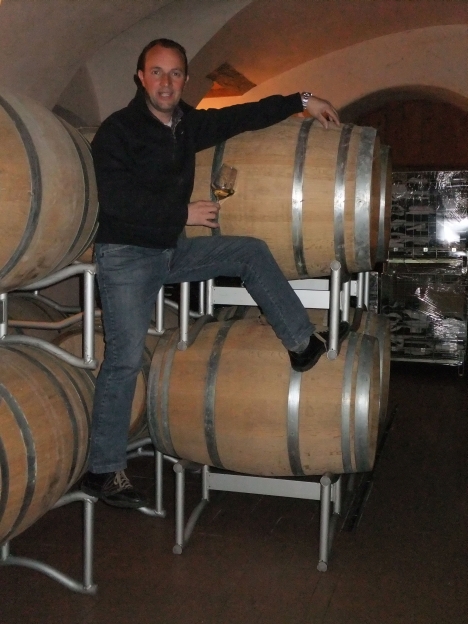 |
| Marco Zanoni (Source: Marco Zanoni) |
Besides these two wines, Marco Zanoni also produces the white wines Chardonnay, Manzoni Bianco and Traminer. Like the two wines described above, these are also much more ripe than one is used to from wines - especially white wines - from Trentino. See also here.
Prices ex farm: the white wines cost 13 euros, the red wine 15 euros.
Visitors are always welcome by appointment.
Azienda Agricola Maso Furli
Via Furli, 32
Pressano di Lavis (TN)
Tel.: ++39 0461 240667
Email: masofurli@alice.it
www.masofurli.it
Az. Agr. Cesconi
With 20 hectares of vineyards and an average annual production of 100,000 bottles, the Cesconi winery is the largest of the "Pressano faction". However, the spirit that prevails here and the way work is done is no different from that of the smaller colleagues. The basic wines, however, which do not exist in this sense at Maso Furli and Fanti, are conceived differently. They are fruity wines to be drunk young. Nosiola, Chardonnay, Manzoni Bianco, Traminer and Pinot Grigio are offered as basic wines. They are characterised by clear, fresh varietal character. In the selection wines, the white wine cuvée 'Olivar', the single-varietal Lagrein 'Pletter' and the 'Pivier', which is mainly made from Merlot, are produced. The grapes for the first two wines come from the oldest vines in the Pressano vineyards. The grapes for the 'Pivier' grow in Dro in the Valle dei Laghi. There are also two sparkling wines. Both are produced in the classic bottle fermentation process, as is customary in Trentino. What is not usual, however, is the length of the maturing period: even the basic version matures for 40 months on the yeast and for the Riserva, which is always bottled as a vintage sparkling wine, it is even 60 (!) months. Both are single-varietal Chardonnay, which, despite the extremely long ripening, present themselves as very delicate, elegant and incredibly fresh; at the same time with a lot of depth and intensity. Like good red wines, both sparkling wines should be opened some time before drinking.
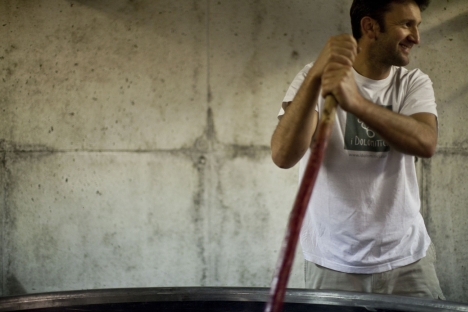 |
| Roberto Cesconi (Source: Cesconi) |
The Cesconis also offer non-alcoholic beverages: a tasty apple juice - ideal for those who are visiting the winery with their children - and a first-class extra virgin olive oil from the Valle dei Laghi.
Prices ex farm: 9 € (Manzoni Bianco) to 20 € (Selektion Pivier); the sparkling wines cost 15 and 25 € respectively.
Visitors are always welcome by appointment.
Azienda Agricola Casconi
Via Marconi, 39
38015 Pressano di Lavis (TN)
Tel.: ++39 0461 240355
Email: info@cesconi.it
www.cesconi.it
Rovereto and the surrounding area - diversity on the right, left, over and along the Adige river
Like everywhere else in Trentino, there is an enormous variety of wines in the south of the region near Rovereto. In addition to the white wine varieties Chardonnay, Pinot Grigio, Traminer and Sauvignon Blanc, which are also cultivated in all other sub-zones of Trentino, as well as the red Cabernet Franc, Cabernet Sauvignon and Merlot, there is also the elegant, fresh-fruity Marzemino here. And: Here, wine is not only cultivated in very high altitudes, but also in the middle of the city. Eugenio Rosi cultivates the grapes for his most expensive wine in a park in the centre of Rovereto and Elisabetta Dalzocchio her Pinot Noir at a lofty height surrounded by pines, firs and oaks.
Eugenio Rosi
I met Eugenio Rosi at the Merano Wine Festival in 2006. He had a small stand there in the 'Vini estremi' section, where - as the name suggests - wines were presented that were strikingly different from other wines because of their origin and/or their special way of making them. In Eugenio Rosi's case, it was not only his wines that were out of the ordinary. With his gentle, calm smile and his long Indian mane, he himself seemed like a foreign body in the hustle and bustle of the Wine Festival.
 |
| Eugenio Rosi (Source: Roland Brunner) |
And his wines radiated the same calm. They were extreme, but not in a striking, gimmicky way. In the last few years, I think they have gained something more: They now have even more down-to-earthness. His white wine cuvée 'Anosis' fermented on the skins (currently Pinot Bianco, Nosiola, Chardonnay) shows the typical spicy dry fruit component of wines made in this way, combined with fresh, mineral mountain wine aroma. The same applies to the red wines. They are all intense and at the same time fine, racy wines with a delicate core. Starting with the Marzemino 'Poiema', where 30 percent of the grapes are dried. I am not really a friend of concentration, because many wines south of the Alps are already too concentrated for me. But if Eugenio Rosi hadn't told me that his Marzemino is partly made from dried grapes - I would never have noticed. It is a mountain wine par excellance - intense without being heavy, fully fruity, fine and elegant. The same was repeated with the other red wines, which, although not made from dried grapes, tend to be darker by nature, such as the Cabernet Franc, whose grapes are grown in a park in the middle of Rovereto, and the Cabernet/Merlot - Cuvée 'Esegesi'. For Eugenio Rosi, all these wines, in addition to their fullness and intensity, always have delicate, animating and fresh components. "If you can't feel the mountains in a wine from Trentino, regardless of the variety, it doesn't make sense to me," says Eugenio Rosi. This even applies to the intense, powerful straw wine 'Doron', made from dried Marzemino grapes, and to the hearty, juicy rosé.
Prices ex farm: €8.50 (rosé) to €22.50 (Cabernet Franc).
Visitors are always welcome by appointment.
Rosi Eugenio
Via Novembre, 7
38060 Calliano (TN)
Tel.: +39 3333 752583
Email: rosieugenio.viticoltore@gmail.com
Elisabetta Dalzocchio
A touch of Burgundy wafts over the Dalzocchio vineyard. This is partly because Pinot Noir is grown here and nothing else, and partly because the estate with its surrounding stone walls is reminiscent of Burgundy - although in Burgundy you don't have such a magnificent view both up to the Dolomites and down to the town of Rovereto.
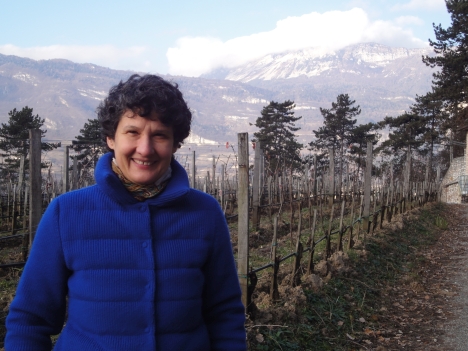 |
| Elisabetta Dalzocchio (Source: Roland Brunner) |
Elisabetta Dalzocchio's father Riccardo was the founder of the winery and the source of its ideas. A trip to Burgundy awakened in him a passion for the wines of this region: Chardonnay and Pinot Noir, both of which have been at home in Trentino for over 100 years now. Money was no problem and so he was able to set up a winery according to his ideas and produce exclusively the two wines he liked best. But since two hectares make extremely little wine given Riccardo Dalzocchio's quality ideas and the associated low yields per hectare, the decision was made four years ago to produce only Pinot Noir. On the vineyards situated at an altitude of 400 metres, surrounded by the city forest, which provides freshness and strong day/night temperature fluctuations, the conditions for Pinot Noir are excellent. On the one hand, it is pleasantly accessible and elegant, but at the same time clearly structured, slightly austere and also ripe - a real mountain Pinot Noir. I have to admit that I have not drunk much Pinot Noir from Trentino so far. But even with this limited experience, I dare to say that the Dalzocchio - Pinot Noir is certainly one of the best from Trentino.
Price ex farm: € 25 euros
Visitors are always welcome by appointment.
Azienda Agricola Dalzocchio Elisabetta
Via Vallunga Seconda, 50
38068 Rovereto (TN)
Tel.: +39 0464 668933
Email: e.dalzocchio@tin.it
www.dalzocchio.it
Marco Zani/Castel Naorna
When Marco Zani took over his parents' farm in 1988, he wanted to produce only two wines: A great white wine and a great red wine. That's what he did and he succeeded quite well. His wines were regularly in the finals for the 3 glasses award of the Gambero Rosso and also received the best reviews from other wine publications. "Both wines, however, were cuvées from different varieties and wines from Trentino - no matter how good and highly awarded they are - have a hard time selling if there is no grape variety on their label. People here are simply not used to Chateau wines," says Marco Zani. That's why, when he switched to organic farming in 2007, he decided to produce single-varietal wines again. It was a decision brought about by economic constraints, but certainly not a bad one. The Castel Naorna vineyards, with their fresh climate due to the altitude and south-east exposure, and soils composed of limestone, marble, porphyry, basalt and slate, are not so well suited for heavy, structured 'great' wines. Marco Zani's wines are 'great' in a different way: Through their fresh, juicy, clearly structured character. Whereby 'fresh' should not be confused with superficial and young to drink. All Castel Naorna wines need to mature. That is why they are always sold only in the second year after the harvest and then still have a bright future ahead of them. An example is a 2009 Nosiola, which Marco Zani opened during my visit. A ripe wine, without a trace of ageing, in which fresh floral aromas combined with delicate nutty components and which presented itself in its fine, elegant way, long and persistent on the palate. In addition to this autoctonic Trentino classic, Marco Zani also produces a white wine cuvée as well as the red wines Lagrein, Merlot and a red wine cuvée of Lagrein, Merlot, Cabernet Sauvignon, Cabernet Franc and Teroldego.
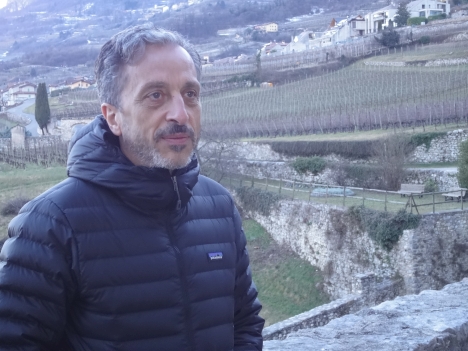 |
| Marco Zani (Source: Roland Brunner) |
Marco Zani is particularly proud of his sparkling wine, a single-varietal Chardonnay Extra Brut. With this product, Marco Zani is in a way returning to the (modern) origins of Castel Noarna. Because when his father acquired the castle in 1974, he mainly cultivated Chardonnay grapes, which were in great demand at the famous Ferrari sparkling wine house in Trento. Even though the Blanc de Blanc of Castel Noarna is not labelled 'Trento DOC', it is a classic representative of the bottle-fermented Trentino sparkling wines: Intense, delicate and delicately fruity; with depth but without any heaviness.
Prices ex farm: the wines cost between 11 and 19 euros, the sparkling wine 19 euros.
Wine tastings and castle tours are available from the beginning of May to the end of October by appointment.
Azienda Agricola Castel Noarna
Via Castelnuovo, 19
38068 Noarna di Nogaredo (TN)
Tel.: +39 0464 41329
Email: info@castelnoarna.com
www.castelnoarna.com
Az. Agr. Vilár di Luigi Spagnolli
Until the mid-90s, Luigi "Gigi" Spagnolli ran the Enrico Spagnolli winery in Isera, which was founded by his father. The Enrico Spagnolli Winery was and still is a classic "old-school" private winery in Trentino, which processes not only its own grapes but also those supplied by contract winemakers. The Spagnolli winery still has an excellent reputation today, which is mainly due to the positive experience of the Lake Garda holidaymakers who like to stop here. The quality of the wines is very good in relation to the price and the atmosphere is extremely warm, so that almost everyone who has been here once is happy to return.
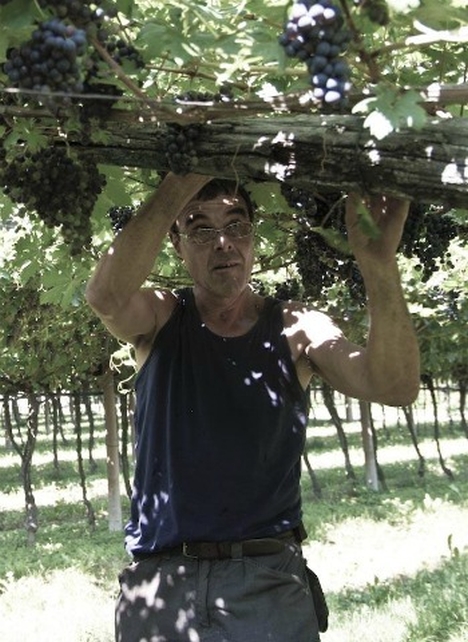 |
| Luigi 'Gigi' Spagnolli (Source: Spagnolli) |
Luigi Spagnolli could have had a relatively comfortable life had he continued to run his parents' family business. "But I wanted something different. Above all, I wanted to get out of the cellar and into the vineyard so that I could accompany the development of my wines from the beginning to the end. And I wanted to make all my wines entirely according to my own ideas - without any compromises. And that is only possible with rather small quantities," says Luigi Spagnolli. "Because, if you have to sell a certain quantity, you are always more or less forced to adapt to market necessities. I want to make wines that really taste of the soil in which they grow. For that, I also accept that the wines don't taste good to everyone." Statements like these are heard more and more often lately and therefore sound a bit hackneyed. But it is not the business of the calm and decidedly self-critical Luigi Spagnolli to talk in platitudes. On the contrary - he is a man who does one hundred percent what he says. He proves this with his wines. First and foremost with his Nosiola selection 'Sass Biank', vinified in amphorae. A wine that tastes as it is called: "White Rock". Austere, cool, almost meagre with racy acidity, at which I am sure many will wave it off from the outset. But anyone who gets involved with this wine will be thrilled by its unobtrusive persistence and delicacy. A wine without anything superfluous - pure mountain terroir. In addition to this wine, Luigi Spagnolli also produces a basic version of his Nosiola, Müller-Thurgau and Gewürztraminer, the autoctone red wine Marzemino, a single-varietal Cabernet Sauvignon and the cuvée 'Morela' made of Cabernet Sauvignon, Cabernet Franc, Merlot, Lagrein, Teroldego and some Tempranillo.
Detailed descriptions of the wines can be found here.
Prices ex farm: 8.50 euros (basic Nosiola) to 13 euros (Morela).
Visitors are always welcome by appointment.
Azienda Agricola Vilar di Luigi Spagnolli
Via Cavolavilla, 35
38060 Villa Lagarina (TN)
Tel.: +39 340 7243016
Email: luigispagnolli@vilar.it
Ciso: All for One
Narciso ('Ciso') is the name of the farmer who gave the members of the Dolomitici a vineyard in Mama d'Avio in the far south of Trentino. Narciso was a hard-working winegrower who spared no effort when it came to working his vineyard. But what he shied away from like the devil shies away from holy water were expenses that he felt were unnecessary. And he felt it was unnecessary to replace his over 100-year-old phylloxera-resistant vines of the local Lambrusco a foglia frastagliata variety (which has nothing to do with the Lambrusco from Emilia-Romagna) with more productive and marketable varieties such as Pinot Grigio or Merlot. Nor did Narciso replace his pearls, which require a lot of work, with other forms of cultivation that are easier and can be worked by machine. 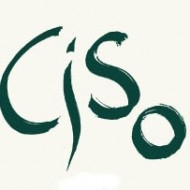 The Dolomitici now benefit from this work ethic and Narciso's thriftiness. For these old vines on the alluvial soils of the Adige are a treasure. Even today, phylloxera doesn't stand a chance because of the sandy subsoil, and the pergola training is just right for the wine that grows here. That is why the Dolomitici cultivate the vineyard just as Narciso once did. As with Narciso, maize, beans, tobacco and other useful plants grow between or under the vines, creating a biodiversity that is practically non-existent in the modern monoculture "wine". What distinguishes the Dolomitici from Narciso, however, is their greater knowledge and experience in winemaking, as well as better cellar techniques. And this enables them to produce a high-quality wine from the treasure that Narciso bequeathed them with the old vines of his unique vineyard: fine, independent, with intense, crisp fruit and a refreshing, decidedly 'trinky' character. In honour of the former owner of the vineyard, the community wine was christened 'Ciso'.
The Dolomitici now benefit from this work ethic and Narciso's thriftiness. For these old vines on the alluvial soils of the Adige are a treasure. Even today, phylloxera doesn't stand a chance because of the sandy subsoil, and the pergola training is just right for the wine that grows here. That is why the Dolomitici cultivate the vineyard just as Narciso once did. As with Narciso, maize, beans, tobacco and other useful plants grow between or under the vines, creating a biodiversity that is practically non-existent in the modern monoculture "wine". What distinguishes the Dolomitici from Narciso, however, is their greater knowledge and experience in winemaking, as well as better cellar techniques. And this enables them to produce a high-quality wine from the treasure that Narciso bequeathed them with the old vines of his unique vineyard: fine, independent, with intense, crisp fruit and a refreshing, decidedly 'trinky' character. In honour of the former owner of the vineyard, the community wine was christened 'Ciso'.
The Ciso is available from all Dolomitici winegrowers at a price of 17.50 euros.
Restaurant recommendations in Trentino
I had excellent food and drink in these restaurants during my Trentino trip:
Trattoria Vecchia Sorni
Lorenzo Callegari has learned his trade in some of the best restaurants in Europe, where fine, refined, artfully composed dishes are served - in a noble ambience and usually for a lot of money. For almost 20 years now, Lorenzo has been offering fine, refined, artfully composed dishes in a simple but very refined ambience - for decidedly little money. With the change from the sophisticated kitchens of the expensive restaurants to the local trattoria, the fine, refined, artfully composed food offer has been expanded by a few more dimensions: seasonality, locality as well as consideration of organic criteria in the selection of ingredients and an extremely loving preparation of the dishes. The same applies to the wine selection, 90% of which consists of excellent wines from Trentino producers. And not just from the well-known names. Here you can always make exciting discoveries and get to know excellent growths from unknown producers. Two sparkling wines, white wines, red wines and dessert wines are offered by the glass. Moderate prices, too, and generous pouring! For a 3-course meal with enough wine, you pay between 30 and 35 euros. The Vecchia Sorni has rightly become an institution. Trentino's top producer Mario Pojer even once called it the best restaurant in Trentino!
Opening hours: Tuesday - Sunday midday from 12 - 14.30, evening from 19 - 22.30.
Trattoria Vecchia Sorni
Piazza Assunta, 40
38015 Sorni di Lavis (TN)
Tel.: +39 0461 870541
www.trattoriavecchiasorni.it
Ristorante Da Silvio
I have known 'Da Silvio' for almost 30 years now and have visited it on almost every trip to Trentino. It is a restaurant that can be addictive. The colourful, Mediterranean ambience, designed by Riccardo Schweitzer, a friend of Pablo Picasso, the fine, light regional cuisine and, above all, the warmth of the Manna family make every visit an all-round pleasure. The imaginative refinement of down-to-earth, regional dishes and the use of high-quality basic products distinguish this restaurant. Unusual for a mountainous region like Trentino: there are many vegetarian dishes on the menu. A speciality of the house is the "Altamira", a hot stone on which you can cook what you have chosen yourself at the table.
The wine list leaves practically nothing to be desired in terms of Trentino, South Tyrol and the rest of Italy, and also has one or two highlights from France. The quality of the house wines - Pinot Grigio, Schiava and Teroldego - from the neighbouring Endrizzi winery, one of the top addresses in Trentino, is very pleasing.
Prices range around 10 euros for antipasti and primi, between 15 and 20 euros for main courses, and homemade desserts are 8 euros.
Ristorante Da Silvio
Localita' Masetto, 2
38010 Faedo (TN)
Tel.: +39 0461 650324
Email: maramanna@virgilio.it
Locanda delle Tre Chiavi
Sergio Valentini and his wife Annarita have dedicated themselves entirely to the local specialities and traditions of their homeland. Whether meat, fish, flour, vinegar, wine, cheese, herbs, honey... everything is sourced from Trentino producers whose names are neatly listed on the menu. The motto is "Menu km 0" (zero-kilometre menu). This means that, as far as possible, no products are used that have to be transported more than 20/30 kilometres. In the kitchen, these source products are skilfully refined. It goes without saying that the choice of dishes depends on the season. And the friendly hosts also show that excellent quality does not have to be expensive. Starters cost between 9 and 12 euros, primi 10 to 13 euros, main courses 12 to 23 euros and desserts are available at a standard price of 7 euros. The wine selection and service are exemplary. There is always a large selection of high-quality wines on open tap.
Opening hours: Tuesday - Friday from 12 to 2 pm and from 7 to 10 pm, Saturday from 12 to 3 pm and from 7 pm to 10.30 pm; open on Sunday from 12 to 3 pm.
Locanda delle Tre Chiavi
Via Vannetti, 8
38060 Isera (TN)
Tel.: +39 0464 423721
Email: info@locandadelletrechiavi.it
Casa del Vino della Vallagarina
The Casa del Vino (House of Wine) in Isera has become an institution. It is mentioned in every serious Trentino travel guide. And rightly so. A stylish palazzo in the middle of Isera and a spacious terrace with a magnificent view of the Vallagarina form the outer setting. The restaurant serves Trentino regional cuisine of a very high standard and you can order all the wines of the Vallagarina by the glass in the restaurant or take them home at farm-gate prices. The idea for this project came from a group of producers from the Vallagarina in the early 1990s when they were travelling in Burgundy and visited a bistro where the otherwise unaffordable top Burgundies were offered by the glass. This fascinated them so much that they founded a cooperative with the aim of creating such an establishment in Vallagarina as well. The municipality of Isera provided the stylish premises and the idea became reality.
The prices are moderate. Depending on the quality, wines cost 3.50 euros to 6 euros for a well-poured glass and a 3-course meal is 30 euros. A little less if you choose a primo (pasta); a little more if you choose a secondo (meat or fish dish). But you can also have typical Trentino specialities as a snack from 2 p.m. onwards, or simply drop in for a glass of wine, spumante or a caffè.
Open all year round. Hot meals are available from 12 - 14 h and from 19 h.
Casa del Vino della Vallagarina
Piazza S. Vincenzo, 1
38060 Isera (TN)
Tel.: +39 0464 486057
Email: info@casadelvino.info
www.casadelvino.info